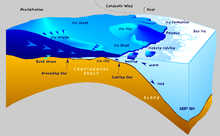
Back بولينيا (جغرافيا) Arabic Йылыу Bashkir Pruoperša BAT-SMG Полини (география) Bulgarian Polínia (glaciologia) Catalan Polynie Czech Йăлу CV Polynja Danish Polynja German Polinio Esperanto



A polynya (/pəˈlɪnjə/) is an area of open water surrounded by sea ice.[1] It is now used as a geographical term for an area of unfrozen seawater within otherwise contiguous pack ice or fast ice. It is a loanword from the Russian полынья (Russian pronunciation: [pəɫɨˈnʲja]), which refers to a natural ice hole and was adopted in the 19th century by polar explorers to describe navigable portions of the sea.[2][3]
There are two main types of polynyas: coastal polynyas, which can be found year-round near the Antarctic and Arctic coasts and are mainly created by strong winds pushing the ice away from the coast, and mid-sea or open-ocean polynyas, which may be found more sporadically in the middle of ice pack in certain locations, especially around Antarctica. These locations are generally preconditioned by certain oceanic dynamics.
One of the most famous mid-sea polynyas is the Weddell Polynya, also known as the Maud Rise Polynya,[4] which occurs in the Lazarev Sea over the Maud Rise seamount. It was first spotted in September 1973 and persisted through multiple winters (1974–1976), and recently recurred in September 2017.[5]
- ^ W.J. Stringer and J.E. Groves. 1991. Extent of Polynyas in the Bering and Chukchi Seas
- ^ Sherard Osborn, Peter Wells and A. Petermann. 1866. Proceedings of the Royal Geographical Society of Australia, Vol 12 no 2 1867–1868 pp 92–113 On the Exploration of the North Polar Region
- ^ polynya, Merriam Webster Dictionary
- ^ Francis, Diana; Eayrs, Clare; Cuesta, Juan; Holland, David (2019). "Polar Cyclones at the Origin of the Reoccurrence of the Maud Rise Polynya in Austral Winter 2017". Journal of Geophysical Research: Atmospheres. 124 (10): 5251–5267. Bibcode:2019JGRD..124.5251F. doi:10.1029/2019JD030618. ISSN 2169-8996. S2CID 149497432.
- ^ Weddell Polynya, NASA, 1999